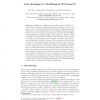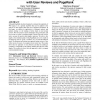1091 search results - page 68 / 219 » Swarming to rank for information retrieval |
CIKM
2007
Springer
14 years 3 months ago
2007
Springer
Modern web search engines are expected to return top-k results efficiently given a query. Although many dynamic index pruning strategies have been proposed for efficient top-k com...
ECIR
2009
Springer
14 years 6 months ago
2009
Springer
Ranking for multilingual information retrieval (MLIR) is a task to rank documents of different languages solely based on their relevancy to the query regardless of query’s langu...
CIKM
2010
Springer
13 years 7 months ago
2010
Springer
Related entity finding is the task of returning a ranked list of homepages of relevant entities of a specified type that need to engage in a given relationship with a given sour...
CIKM
2008
Springer
13 years 10 months ago
2008
Springer
Although PageRank has been designed to estimate the popularity of Web pages, it is a general algorithm that can be applied to the analysis of other graphs other than one of hypert...
ETRA
2010
ACM
14 years 3 months ago
2010
ACM
In order to help users navigate an image search system, one could provide explicit information on a small set of images as to which of them are relevant or not to their task. Thes...


